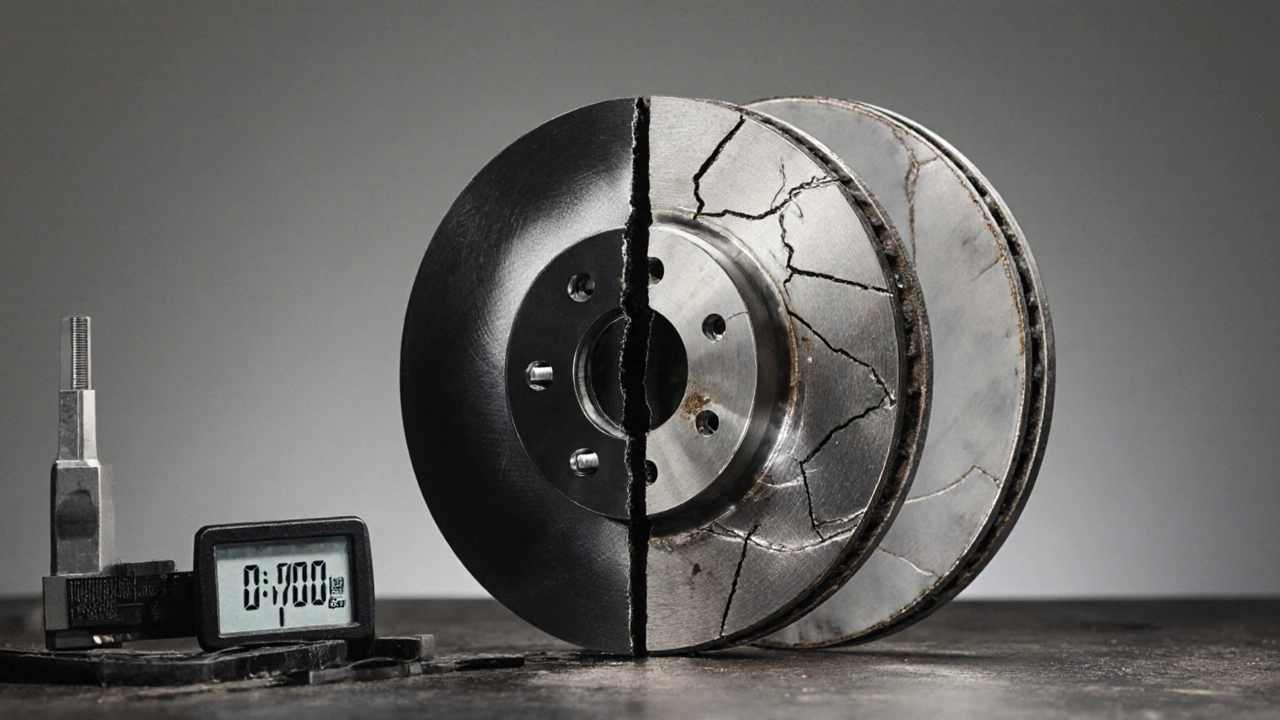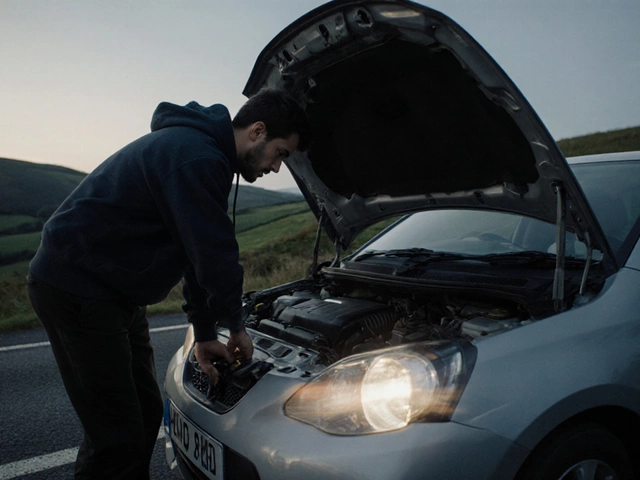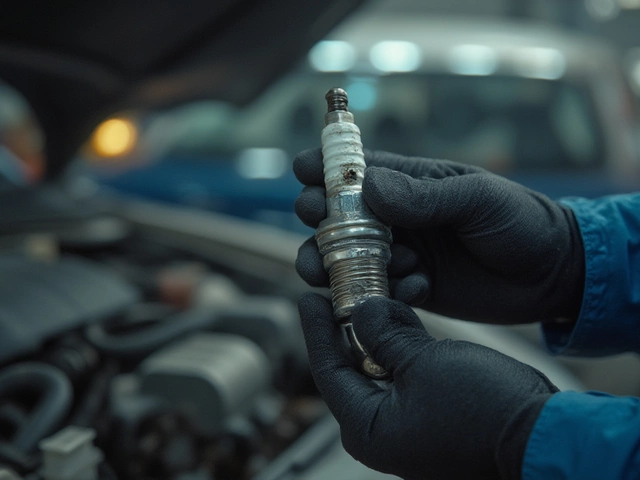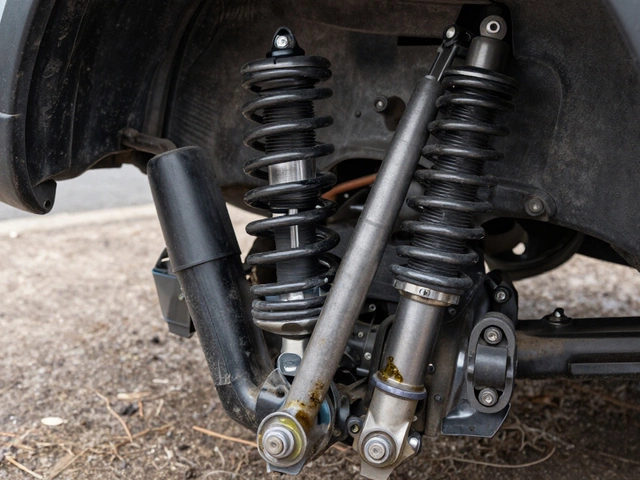Brake Rotor Lifespan Calculator
Estimate how many miles your brake rotors will last based on your driving habits and vehicle conditions. Your vehicle's actual lifespan may vary based on factors like climate, pad quality, and maintenance.
Brake rotors don’t last forever. If you’ve ever heard a squeal, felt a vibration, or noticed your car taking longer to stop, it’s not just the brake pads wearing out-it’s probably the rotors too. Many drivers think rotors last for years without thinking about them, but that’s not how it works. The truth is, brake rotors wear down just like pads, and ignoring them can turn a simple repair into a dangerous and expensive mess.
What brake rotors actually do
Brake rotors are the metal discs attached to each wheel. When you press the brake pedal, the calipers clamp the brake pads against these rotors. That friction slows the wheel down-and eventually stops the car. Rotors handle a lot of heat and stress. Every time you brake hard, especially on a highway or downhill, the rotor absorbs energy and gets hot. Over time, that heat warps the surface, wears down the metal, and creates grooves or uneven spots.
They’re not meant to last the life of the car. Even if you drive gently, rotors wear. And if you drive in the city with lots of stop-and-go traffic, or haul heavy loads, they wear faster.
How long do brake rotors usually last?
Most brake rotors last between 30,000 and 70,000 miles. But that’s not a rule-it’s a range. Some last longer. Some don’t make it to 30,000. It depends on a few key things:
- Driving style: Aggressive braking, frequent hard stops, or riding the brake on hills wears rotors faster.
- Vehicle weight: Heavier cars-SUVs, trucks, vans-put more pressure on rotors.
- Climate: Wet, salty roads in winter corrode rotors. Rust can pit the surface, reducing braking power.
- Brake pad quality: Cheap, hard brake pads grind against the rotor like sandpaper. High-quality pads wear evenly and protect the rotor.
- Maintenance: If you skip brake inspections, small problems turn into big ones.
In the UK, where wet weather and urban driving are common, many drivers see rotor wear by 40,000 miles. If you’re driving a Ford Focus or a Volkswagen Golf with normal city use, expect to replace rotors around the same time as the pads-every 30,000 to 50,000 miles.
Signs your rotors are worn out
You don’t need a mechanic to tell you when rotors are bad. Your car will tell you-loudly and sometimes painfully.
- Vibration in the steering wheel: If the wheel shakes when you brake, especially at higher speeds, the rotor is warped. It’s not spinning flat anymore.
- Grinding or growling noises: A metallic scraping sound means the pads are gone and metal is hitting metal. This is serious. You’re damaging the rotor beyond repair.
- Visible grooves or ridges: Look through the wheel. If you see deep lines or a raised edge on the rotor surface, it’s worn unevenly. That’s not normal wear-it’s damage.
- Longer stopping distance: If your car feels like it’s not responding as quickly as it used to, the rotors may be glazed or too thin to dissipate heat properly.
- Brake warning light: Some modern cars have sensors that detect rotor thickness. If the light comes on, don’t ignore it.
One real example: a customer in Manchester brought in a 2018 Honda Civic with 48,000 miles. The pads were fine, but the rotors had deep grooves from using cheap aftermarket pads. The customer didn’t notice the vibration until one rainy day, when braking felt spongy. Replacing just the pads would’ve been a waste. The rotors had to go too.

Should you always replace rotors when replacing brake pads?
No. But you should always check them.
Many shops push rotor replacement because it’s more profitable. But if your rotors are still smooth, above the minimum thickness (usually stamped on the rotor edge), and not warped, you can keep them. A good mechanic will measure the thickness with a micrometer and check for warping with a dial indicator.
Here’s the rule: if the rotor is within 0.005 inches of the minimum thickness, or if it has any cracks, deep scoring, or heat cracks, replace it. If it’s in good shape, resurfacing (turning) it can extend its life-but only if it’s thick enough. Most modern rotors are too thin to be turned safely anymore. Manufacturers design them to be replaced, not repaired.
Cost to replace brake rotors
Replacing brake rotors isn’t cheap, but it’s cheaper than an accident.
For a typical family car like a Toyota Corolla or Hyundai i30:
- Rotors alone: £60-£120 per pair (front or rear)
- Brake pads: £40-£80 per axle
- Labor: £80-£150 for both front or rear axle
So, replacing both front pads and rotors usually runs £200-£350. If you’re doing it yourself, you can cut labor costs, but you’ll need a torque wrench and jack stands. Don’t skip the torque specs-over-tightened bolts can warp rotors.
Don’t buy the cheapest rotors you can find. Cheap rotors warp faster and don’t handle heat well. Look for brands like Akebono, Brembo, or Centric. They’re pricier, but they last longer and brake smoother.
How to make rotors last longer
You can’t stop wear entirely, but you can slow it down.
- Drive smoothly: Anticipate stops. Ease off the gas early instead of braking hard at the last second.
- Avoid riding the brake: Especially on hills. Use engine braking by downshifting.
- Use quality brake pads: Ceramic or semi-metallic pads from trusted brands wear evenly and protect rotors.
- Check your brakes every 10,000 miles: Especially before winter. Moisture and salt eat rotors fast.
- Don’t wash hot rotors with cold water: Thermal shock can crack them. Let them cool naturally.
One simple habit: after a long drive, park in a safe spot and let the car sit for 10 minutes. That lets the rotors cool slowly and evenly.

What happens if you ignore worn rotors?
Ignoring worn rotors doesn’t just mean worse braking-it means damage spreads.
Warped rotors cause uneven pad wear, which means you’ll need new pads sooner. Severely worn rotors can crack under pressure. If a rotor cracks while driving, you could lose braking power on that wheel. That’s not a minor issue-it’s a crash risk.
And if you keep driving with metal-on-metal contact, you can destroy the caliper, damage the brake lines, or even overheat the wheel bearing. Repair costs can jump from £300 to over £1,000.
It’s not worth the risk.
When to replace rotors: the quick checklist
Replace rotors if any of these are true:
- Thickness is below manufacturer’s minimum spec
- Visible grooves, ridges, or cracks
- Steering wheel shakes when braking
- Grinding noise is present
- Brake pedal feels spongy or requires more pressure
- Rotors have been resurfaced before and are now too thin
If none of these apply, and the rotors are smooth and thick enough, you can reuse them with new pads. But always measure. Don’t guess.
Rotors and brake pads: always replace together?
Not always-but nearly always.
Old pads leave grooves on new rotors. New pads need a smooth, flat surface to bed in properly. If you put new pads on old, worn rotors, you’ll get noise, vibration, and uneven braking. The pads won’t last as long either.
It’s like putting new tires on a bent rim. It might seem okay at first, but it won’t perform right-and it’ll wear out faster.
Best practice: replace pads and rotors as a set. It’s more expensive upfront, but it gives you smoother braking, longer life, and fewer surprises down the road.
How often should I check my brake rotors?
Check your brake rotors every 10,000 miles or during every other oil change. If you drive in heavy traffic, on hilly roads, or in wet conditions, check them every 5,000 miles. A visual inspection through the wheel and a quick test for vibrations while braking can catch problems early.
Can I drive with bad brake rotors?
You can, but you shouldn’t. Driving with warped, cracked, or severely worn rotors reduces braking power and increases stopping distance. It can also damage other parts like calipers and brake lines. If you hear grinding or feel shaking, get it checked immediately. It’s not just a repair-it’s a safety issue.
Do I need to replace all four rotors at once?
You don’t have to, but you should. Replacing only the front or only the rear can cause uneven braking, which pulls the car to one side. It’s safer and more effective to replace them in pairs-front or rear together. If both front and rear are worn, replace all four. Consistency matters for control and safety.
What’s the minimum thickness for brake rotors?
The minimum thickness is stamped on the rotor’s edge or listed in your vehicle’s service manual. For most cars, it’s between 20mm and 24mm. If the rotor is within 1mm of that limit, replace it. Even if it looks okay, thin rotors overheat faster and are more likely to warp or crack under stress.
Can brake rotors be resurfaced instead of replaced?
Resurfacing (turning) rotors used to be common, but it’s rare now. Most modern rotors are too thin to safely remove material. Even if they can be turned, the result often doesn’t last long. Manufacturers now design rotors to be replaced, not repaired. If a shop offers to turn your rotors, ask them to measure the thickness first. If it’s close to the minimum, just replace them.








